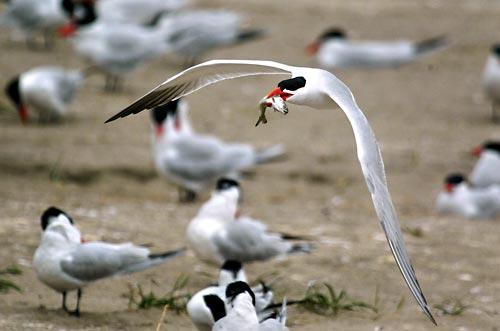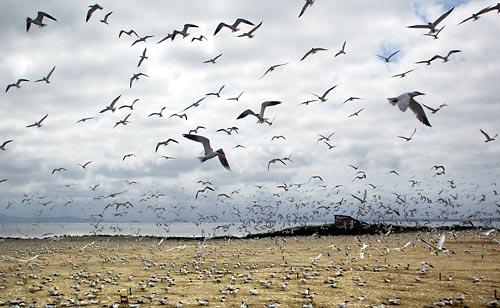forum
library
tutorial
contact

Battling Nature
may be for the Birds
by Craig Welch, Seattle Times staff reporter
Seattle Times - May 15, 2005
|
the film forum library tutorial contact |

|
Battling Nature
by Craig Welch, Seattle Times staff reporter
|
 EAST SAND ISLAND, Columbia River -- On a tiny uninhabited wash of ground near the river's mouth, thousands of squabbling Caspian terns pack the sand like giant cotton balls -- fluttering on the breeze, strutting like little emperors or screeching at one another like an army of monkeys.
EAST SAND ISLAND, Columbia River -- On a tiny uninhabited wash of ground near the river's mouth, thousands of squabbling Caspian terns pack the sand like giant cotton balls -- fluttering on the breeze, strutting like little emperors or screeching at one another like an army of monkeys.
This bird colony has been brought to you by the federal government.
Beginning 20 years ago, when the U.S. Army Corps of Engineers trenched the river to make way for bigger ships, quarrelsome terns from all over settled on sands the corps piled along banks upstream.
They eventually devoured so many endangered salmon and steelhead that federal agencies lured them farther downstream to this island, hoping they would seek other food brought in by the ocean. Still, the terns gorge on too many nearly extinct fish.
Now federal agencies are calling for more radical measures -- splitting up the colony and relocating some birds as far away as San Francisco.
But just as this tern-shuffling odyssey reaches its zenith, yet another problem is emerging on this island: A ravenous colony of 30,000 double-crested cormorants, which eat more protected fish than the terns.
Even on a river as distorted and engineered as the Columbia, there's still a price to pay for fiddling with nature.

"It's going to be the same thing all over again," said Dan Roby, head of the Columbia River bird program for Oregon's Cooperative Fish and Wildlife Research Unit. "Except this colony is still growing, and we don't know when it's going to stop."
The government in the Columbia ecosystem increasingly goes to severe lengths to manipulate one species to help another. Federal workers shoot noisemakers at sea lions for feasting on chinook at the dams. The Bonneville Power Administration pays fishermen a bounty to wipe out salmon-eating pikeminnows.
Just to lure terns to this spot on East Sand Island, workers used sound systems and decoys, stole eggs and built fences, and even smothered birds' old nests with a crop of winter wheat. Then Marines stormed a beach and built the birds a new home.
"We as humans have a pretty long history of saying, 'We didn't understand this system back then -- but now we really do,' " said Julia Parrish, an associate professor and bird expert at the University of Washington. "And, of course, we really only know a bit more than we did."
Thus far federal agencies don't know what to do with the cormorants. But Geoff Dorsey, a U.S. Army Corps of Engineers wildlife biologist, said the bigger birds could make tern management seem simple.
"Yeah," Dorsey said, and exhaled slowly. "It's going to be a problem."
A Ritz for terns
 The 20,000 terns that will eventually arrive here pack so close together that when flushed by disturbance the explosion is like "being stuck inside a snow globe," researcher Ramona Flatz said without dropping her binoculars.
The 20,000 terns that will eventually arrive here pack so close together that when flushed by disturbance the explosion is like "being stuck inside a snow globe," researcher Ramona Flatz said without dropping her binoculars.
She was inside a plywood bird blind on a recent gray day, straining to track a lone feeding tern. "He keeps dropping his fish," she said. "If they drop it, they won't eat it. They take it to the water to wash it off."
While terns are native to the Northwest, that finicky nature helps explain how so many came to be in one spot.
In 1983, the corps piled sand in great mountains on unpopulated, 230-acre vegetated Rice Island. Since terns like nestling on soft sands where they scratch pits for eggs -- and since disturbance had put pressure on their other West Coast haunts -- Rice was an island paradise.
With a smorgasbord of food and virtually no predators, it quickly became the world's largest tern colony -- home to 70 percent of the world's birds.
"It's like we put up a new Ritz Hotel with the best restaurant in New York, and then advertised to the world that anyone can stay for free," Parrish said.
This encampment, for a time, was little more than a curiosity. Then in the late 1990s, scientists learned the birds chomped up to 16 million salmon and steelhead smolts a year -- 17 percent of out-migrating juvenile salmon.
With a dozen runs on the Columbia threatened by extinction -- and predation most problematic for troubled runs of steelhead -- the birds were suddenly cast as a menace.
"Seventy-seven percent of their diet was juvenile salmon," said Dorsey, with the corps. "Our thought was that if you moved them closer to the ocean, their diet would be more diverse; they'd have more things like sardines and anchovies."
So the corps, which owns the islands, and the U.S. Fish and Wildlife Service, which manages birds, agreed to move the terns miles downstream to this place, East Sand Island.
Researcher Ramona Flatz observes the Caspian terns from the bird blind. Risha Sparhawk, another researcher, is in the background.
A military commander, in search of training for his soldiers, offered up six Marines, who landed on East Sand in a squall in February 1999. For two weeks they worked the land like farmers, removing vegetation to create sandy habitat, while workers on Rice Island slowly destroyed their old nests.
"We thought we had a good working hypothesis in moving them to East Sand," Dorsey said.
Overcome by success
It's not that the move was a failure -- far from it.
By 2000, most terns were summering on East Sand. The number of salmon they ate dropped to between 3.5 million and 7.7 million.
Since so few smolts return to rivers as adult fish, the change benefited troubled runs by only a few percentage points. But given the dire straits of some fish, "that's no small drop in the bucket," Roby said.
But after settling a lawsuit with environmentalists (some worried about birds; others feared terns distracted the government from the hard work of dealing with dams or fish habitat), the agencies honed data and reached a new conclusion: East Sand Island was not the best place for all the terns.
Instead, fish scientists decided terns still feast on too many salmon. Smolts surviving the gantlet of dams and predators to make it down river were the strongest.
Meanwhile, changing ocean conditions meant alternative foods such as herring and anchovies might soon be less abundant, meaning the terns' salmon consumption would rise even more.
"We tried to find a solution we thought would be a compromise for both species," said Nanette Seto, who oversees terns for the Fish and Wildlife Service.
Now the agency plans to spend $2.4 million and use its old tactics to lure birds to sites near Sequim, lakes in Oregon, sites near San Francisco. Splitting the colony into smaller groups would keep a collapse at one colony from wiping out the species.
Meanwhile, the National Marine Fisheries Service is trying to figure out what impact birds will have on fish in the new areas.
"We're not really sure what's going to happen," said Roby, who remains optimistic. Terns have shown a willingness to move and to follow birdcalls and decoys, but "going from Rice Island to East Sand Island was only 14 miles."
Said Parrish: "The terns could also not go where they're supposed to, and just end up someplace completely new."
And the corps will soon do more dredging in the estuary, though Dorsey said the agency has a plan to deposit spoils where they won't attract terns.
Either way, that leaves another bird problem in the Columbia.
Unwanted visitors
On the same cool gray day, biologist Brendan Courtot piloted a skiff around East Sand, pointing out row after row of gangly double-crested cormorants -- prehistoric-seeming beasts that croak like frogs.
No one knows precisely why cormorants started showing up, only that before 1989 they numbered in the hundreds. Courtot, the field leader for research on East Sand, said it may be as simple as "we made it easy for them."
The island is free of marine mammals and, since the arrival of the terns, off-limits to boats and people.
"Where are we getting them from? We don't know," Dorsey said. "We don't have the knowledge base. Our emphasis has been on terns."
Wildlife mangers weren't blind to the swelling population but dismissed its significance since salmon make up a mere fraction of the bird's diet. But since cormorants weigh four times more than terns, they're eating fish almost all day long.
"Last year they took, like, 6.4 million salmon," Dorsey said -- significantly more than the amount eaten by terns.
That's why Courtot's work is important. In addition to tracking terns, his workers now count and track the island's cormorants and are experimenting with ways to get those birds to move.
They recently installed posts in the middle of the colony, hoping to attract eagles that might scare off cormorants. So far the move has only half-worked.
"I watched an eagle swoop down and attack one of the cormies," Courtot said, and laughed. "Birds not 15 feet away looked over for a second," then turned back to building their nests.
On a rock outcropping across the river, Courtot's group also recently installed plastic cormorant decoys, which point in all directions, while a solar-powered sound system belts out recorded cormorant calls.
"We just want to see if it's possible to get a few of them to move," he said.
But unlike the picky Caspian terns, cormorants tend to nest on any flat surface -- vertical cliffs, ledges, in trees or on rocks -- and are even found squatting in a ring of old tires. Drawing them to a particular site may prove tricky.
Motoring around the Hitchcockian rock stacked with fake cormorants, Courtot agrees.
"So far we haven't really seen any interest yet at all," he said.
learn more on topics covered in the film
see the video
read the script
learn the songs
discussion forum
